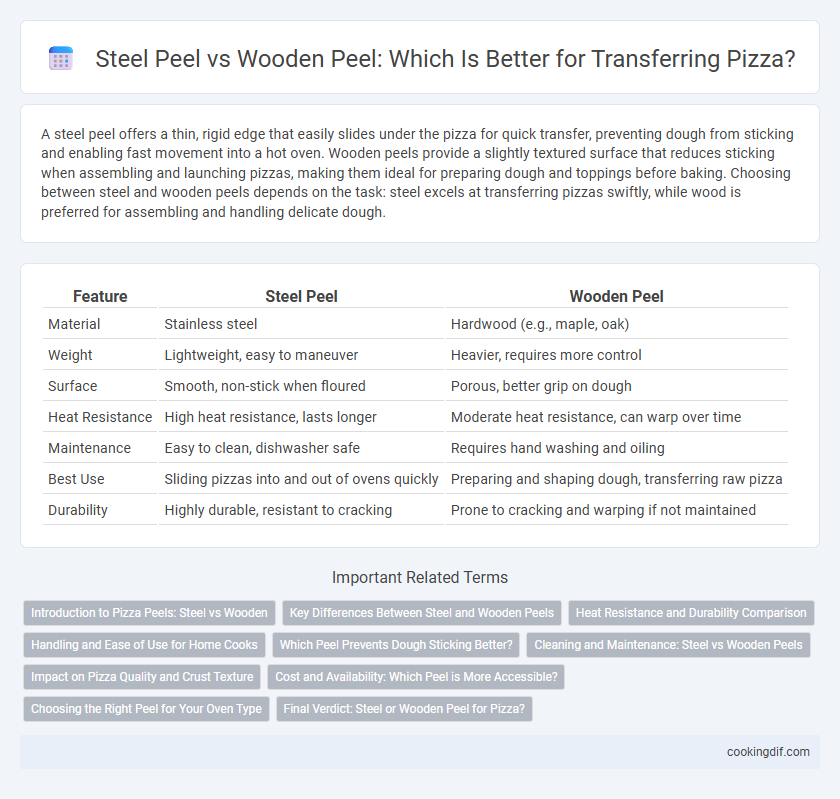A steel peel offers a thin, rigid edge that easily slides under the pizza for quick transfer, preventing dough from sticking and enabling fast movement into a hot oven. Wooden peels provide a slightly textured surface that reduces sticking when assembling and launching pizzas, making them ideal for preparing dough and toppings before baking. Choosing between steel and wooden peels depends on the task: steel excels at transferring pizzas swiftly, while wood is preferred for assembling and handling delicate dough.
Table of Comparison
| Feature | Steel Peel | Wooden Peel |
|---|---|---|
| Material | Stainless steel | Hardwood (e.g., maple, oak) |
| Weight | Lightweight, easy to maneuver | Heavier, requires more control |
| Surface | Smooth, non-stick when floured | Porous, better grip on dough |
| Heat Resistance | High heat resistance, lasts longer | Moderate heat resistance, can warp over time |
| Maintenance | Easy to clean, dishwasher safe | Requires hand washing and oiling |
| Best Use | Sliding pizzas into and out of ovens quickly | Preparing and shaping dough, transferring raw pizza |
| Durability | Highly durable, resistant to cracking | Prone to cracking and warping if not maintained |
Introduction to Pizza Peels: Steel vs Wooden
Pizza peels, essential tools for transferring pies in and out of ovens, come primarily in steel and wooden varieties, each offering distinct benefits. Steel peels are thinner and more durable, facilitating quick and precise pizza transfers, especially in high-heat environments, while wooden peels provide a natural non-stick surface that prevents dough from sticking during preparation. Choosing between steel and wooden pizza peels depends on oven type, pizza style, and personal handling preference, optimizing both baking efficiency and pizza quality.
Key Differences Between Steel and Wooden Peels
Steel peels offer superior strength and durability, making them ideal for sliding heavy pizzas in and out of hot ovens without bending. Wooden peels have a rougher surface that helps prevent dough from sticking, allowing easier handling of raw pizzas but require more maintenance to avoid warping and cracking. Temperature resistance differs significantly, as steel peels withstand high heat better while wooden peels can burn or scorch if left too close to the oven surface.
Heat Resistance and Durability Comparison
Steel peels offer superior heat resistance, making them ideal for transferring pizzas in high-temperature ovens up to 900degF without warping or burning. Wooden peels, while less heat-resistant, provide natural insulation that prevents dough from sticking and are less likely to damage oven surfaces but can scorch or crack over time with heavy exposure to heat. Durability-wise, steel peels resist moisture, cracking, and warping better than wooden peels, which require regular maintenance to prevent deterioration.
Handling and Ease of Use for Home Cooks
Steel peels offer superior durability and a thinner edge, making it easier for home cooks to slide pizzas smoothly onto a stone or oven surface without sticking. Wooden peels provide a rougher texture that prevents dough from sliding prematurely, offering better control when shaping and transferring uncooked pizzas. For ease of use, steel peels excel in handling cooked pizzas quickly, while wooden peels are preferred during preparation due to their non-stick surface for raw dough.
Which Peel Prevents Dough Sticking Better?
Steel peels prevent dough sticking more effectively than wooden peels due to their smooth, non-porous surface that reduces friction and moisture absorption. Wooden peels, while better at holding flour to prevent sticking initially, tend to absorb moisture from the dough, increasing the risk of sticking over time. For consistent, quick pizza transfers with minimal sticking, steel peels outperform wooden alternatives.
Cleaning and Maintenance: Steel vs Wooden Peels
Steel pizza peels are easier to clean and maintain due to their non-porous, rust-resistant surface that simply requires wiping with a damp cloth and occasional mild detergent use. Wooden peels demand more careful upkeep, needing thorough drying to prevent warping and regular oiling to maintain their condition, as they absorb moisture and food particles. Choosing steel peels minimizes hygiene risks with less effort, while wooden peels require consistent maintenance to avoid bacterial buildup and prolong durability.
Impact on Pizza Quality and Crust Texture
Steel peels conduct heat more efficiently, promoting a crispier crust by quickly transferring the pizza onto a hot stone or oven surface. Wooden peels offer a softer, less sticky surface, reducing the risk of dough tearing or sticking, which preserves the integrity of the pizza's shape and texture. Choosing between steel and wooden peels directly affects pizza quality, as steel enhances crust crispiness while wood maintains dough softness during transfer.
Cost and Availability: Which Peel is More Accessible?
Steel peels typically cost more upfront but offer long-term durability, making them a cost-effective choice for frequent pizza makers. Wooden peels are generally more affordable and widely available at most kitchen supply stores, appealing to casual bakers seeking easy access. Availability of steel peels may be limited in some regions, whereas wooden peels are easier to source globally due to their traditional use and simpler manufacturing process.
Choosing the Right Peel for Your Oven Type
Choosing the right pizza peel depends on your oven type and cooking style; steel peels excel in high-heat, commercial ovens with their durability and thin edge for easy pizza transfer. Wooden peels offer better grip and prevent sticking, ideal for home ovens and cold dough handling before baking. Consider steel for rapid, frequent use and wooden for gentle dough support and comfortable maneuvering.
Final Verdict: Steel or Wooden Peel for Pizza?
Steel pizza peels offer superior durability, easy cleaning, and a thin edge that slides quickly under dough, making them ideal for transferring pizzas efficiently. Wooden peels provide a textured surface that prevents dough from sticking and offer a classic aesthetic, but may require more maintenance and can absorb moisture. For optimal performance and longevity, steel peels generally provide better results in transferring pizzas compared to wooden peels.
Steel peel vs Wooden peel for transferring pizza Infographic

 cookingdif.com
cookingdif.com